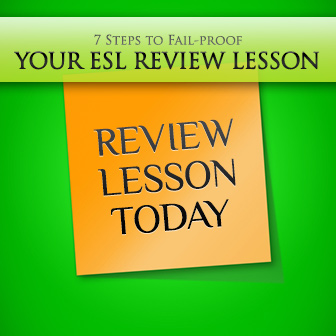8 Top Tips for Giving Your ESL Class a Review Lesson They'll Love


What exactly is a “review lesson”? You’re not teaching anything new, but you’re not testing your students’ knowledge, either. Review lessons are located in this limbo, a nebulous cloud filled with many things, from structures your ESL students have effectively learned and started using, to words they have completely forgotten. It’s grammar, vocabulary and useful phrases all thrown together in the mix.
So how do you create a review lesson that is really useful to your students (and not just a way to buy time till they have the test)?

A review lesson is not some dead expanse of time between the moment your students are learning things and the moment they are tested on it. It is not just a way to fill the time you have before the test. It is an integral part of your overall teaching strategy, an opportunity to consolidate everything you’ve taught into a cohesive language learning experience.
So with this in mind, let’s see 7 ways to fail-proof your review lesson so you and your students make the most of this learning opportunity!

Before you can actually start planning your review lesson/s, you need to look at the big picture, in other words, see where your students started and where they are now, taking into consideration the grammar and vocabulary they learned along the way.
For instance, say they started as beginners. First, they learned to introduce themselves and talk about themselves (verb to be). Then they learned to talk about their everyday activities (simple present). Finally, they learned to talk about what they did at some point in the past (simple past). This is just a simple overview for illustrative purposes, of what a beginner may learn throughout an entire school year, but my goal is to show you how to see the path that leads your students from Point A (starting point) to Point B (where they are now, whether you are reviewing for a chapter test or midyear/final examination).
Next, you’ll need to break down everything you need to review into parts so you can devote the right amount of time to each. But here’s an important caveat. Some teachers like to break the review down into “chapters” or “units” and devote, say, 15 minutes to each. This means that if you’re having a test that covers Units 1 to 5, you’ll break your review into five parts. This may not be the best course of action. What if what your students learned in Units 1 to 3 was relatively simple? What if what they learned in Units 4 and 5 was the hardest? You’ll need to consider your students needs first.
So, this step and number 2 actually go hand in hand. As you go through the material and see the grammar and vocabulary your students need to review, try to remember what they had the most trouble with. Was it the Past Perfect? The Third Conditional? Mark these as points to place some emphasis on during your review. Finally, create review units that make sense and are tailored to your students’ needs, and plan what you’ll review each lesson before the test.
It’s hard for students to keep track of everything they’ve learned. So instead of saying, “We’re going to review for the upcoming midterm examination” say, “We are going to review everything you learned to do in the semester.” As you review, walk your students through each of the goals they’ve met: “First, you learned to introduce yourself and others.”
Instead of reviewing the verb to be just because they saw that in the first unit, review what they learned to do with it. Have them use the verb to be in a variety of contexts: ask them to talk about where they and their classmates are from, or what nationality they are. Don’t launch into a speech about how the verb to be is conjugated. They have that in the book! Review how it’s used and how they can use it.
You can’t review everything they’ve learned by having them talk about it. Review useful expressions and phrases through role plays. Review grammar through games. Review vocabulary through a writing assignment. Just make sure they know that they are reviewing something they learned to do (“Talk about our favorite animals” and not just “animal vocabulary”).
If during the review you see that your students have a particular difficulty, tell them what they should focus on as they study for the test at home and what they can do to continue practicing on their own. For example, students who are having a hard time with the past participles can do this worksheet for extra practice before the test.
Keep this in mind, and you’ll prepare your students to obtain not only top-notch test results, but also a learning experience they won’t forget!
Have you ever used a goal-oriented review before a major test? What are your tips for effective review lessons?